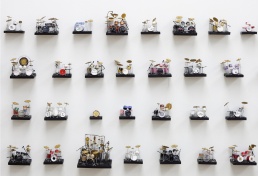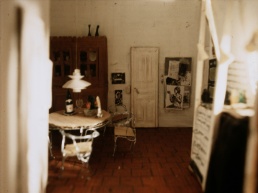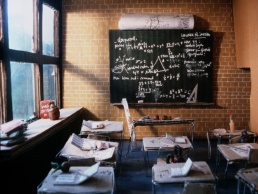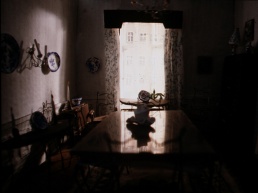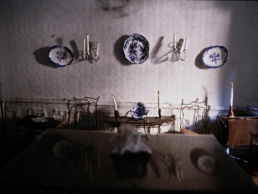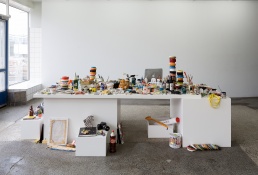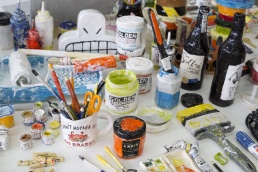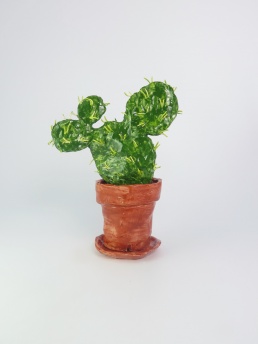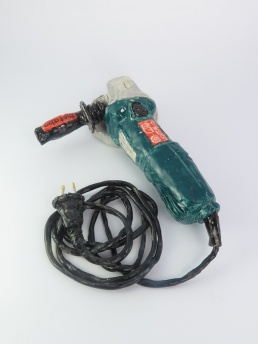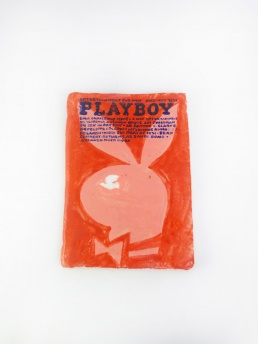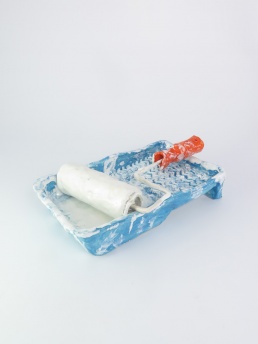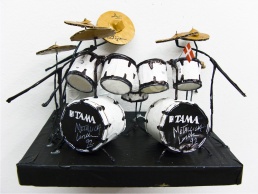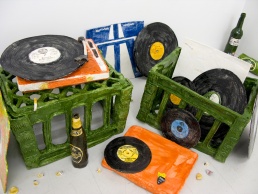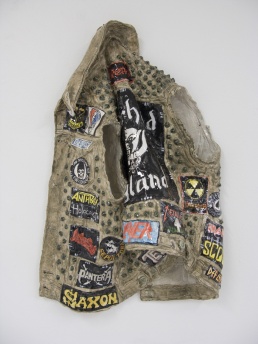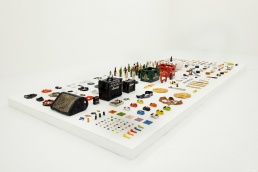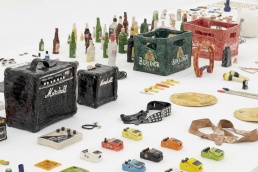This is Rose Eken
Copenhagen-based artist, Rose Eken, recreates objects turning them into miniatures that when put together tells stories of scenes she finds inspiration from. It began at the place where she grew up in, to into music halls, to artists’ personal workspaces. Rose Eken shares her personal story, her process and the value of consistency through discipline.
Interview by Mark Changco.
Artworks by Rose Eken.
Feature Photo by Fryd Frydendahl.
Let’s talk about your history. What led you to do what you’re doing now?
I was born in Copenhagen. I have two older sisters, one writes children’s fiction and the other is an architect and jewelry designer. My mother teaches opera singers and my father was a cardiologist. My parents got divorced when I was 5 years old and I grew up with my mother and sisters.
Before the divorce, we lived in Boston, USA for a year where my parents studied. I guess that year in many ways had an influence on all of us. I don’t remember much to be honest, but I know I learned Danish and English at the same time even though I later forgot English and had to relearn it.
My mother remarried. And even though this marriage didn’t last for that long my stepdad had a huge influence on our lives. He was a printmaker and publisher and worked with all the great Danish artists at the time. So my childhood house was filled with opera singers, painters and sculptures. Of course, this influenced and inspired me.
I think I always knew I wanted to do something creative. For a while I thought I wanted to be an actor or a set designer but I think I realized at 16 that I wanted to do art and I have pretty much pursued it ever since.
The first art I created, well I don’t know, I’ve always made stuff I did art in school since I was very young but would you define what you make then as art? Not sure. I did a lot of drawing and art classes when I was a teenager, some of these works from back then are probably my first artwork but couldn’t say which specifically.
Where did you go to study art?
I studied a BA (Hons) at Edinburgh College of Art in Edinburg, Scotland from 1997 – 2001 and then a Master of Art at Royal College of Art in London, 2001-2003.
“I think I always knew I wanted to do something creative. For a while I thought I wanted to be an actor or a set designer but I think I realized at 16 that I wanted to do art and I have pretty much pursued it ever since.”
Did your parents fully support you in the career you chose?
Well, my parents are divorced so I can only speak for my mom. And yes! She has always supported me but she also taught me the consequences or the difficulty of choosing art as a career.
Did you have mentors that you looked up to along the way?
Not so many, but yes of course there had been people along the way that has helped and shaped my career. A few of my art teachers, my friends and peers, other artist and musicians, my siblings.
Do you have anyone specific in mind you wanted to mention and tell us what was the one thing this person did that influenced you to do what you do?
Well, I could mention my lecturer Peter Rimmer whom was a teacher at Edinburgh College of Art and also my mentor for my first dissertation. We definitely had a LOT of great discussion most of them in the pub. He very much taught me to formulate myself about the arts and to formulate my own project which is essential if you ever wanna make it as an artist in today’s art world.
A Danish artist called Svend Wiig Hansen whom I know since I was 5 years old also had a huge influence in my life. He was very much a different generation but one of the great Danish expressionist. He helped me select my portfolio when I applied to Edinburg College of Art something I will never forget. He passed away only a few months later.
I’m sorry to hear that. When did your interest in recreating objects in daily life develop?
Well somehow, when I look back, I have done this since I was very young. I never really had a proper dolls’ house as a child, so rather I transformed my entire bedroom into a giant installation of small miniature scenarios.
As an artist, I began making works in miniature again; creating small scenes on a large scale in cardboard and masking tape, which I then in turn either photographed or filmed. For my final degree show in 2001 at Edinburg College of Art for example, I did a piece, a slideshow, where I recreated places from memory in miniature places in Copenhagen where I grew up my grandmothers dining room, my mother’s kitchen, my childhood bedroom, etc. basically I made about 10-15 small cardboard interior models which I in turn photographed i.e. I photographed each wall in each space and then projected them at random on a large scale. As such the spectator had to reassemble each interior space in their minds eye. It’s only later I began working with ceramics, painting and embroidery.
In many ways you can say I use my own life as a starting point for what I do but I’m actually not really interested in telling anything about myself per se, rather I aim to trigger people’s own ideas and memories. I set the scene but it is the individual spectator that acts out the ‘play’ or concludes the narration through his or her own association and memory.
How influential was your environment in your art’s development?
I left school at 16 and I started working as a stage technician, at the same time I began making light-design for different bands on the Copenhagen punk/rock scene. This period has in many ways informed my work ever since, as it instilled this fascination with the notion of space; with venues and theaters and the stories they tell when empty. Basically these large dark spaces are made for an audience, when you work there out of hours it’s just a big black (and usually smelly) space which kind of hovers. It awaits the audience, awaiting what is to happen, the arrival of the musicians, the buzzing and talking, the gig, the ecstasy, the successes and failures that will occur on that specific night. This idea of the moment just before or just after something happens and this suspension of space as well as how these places are instilled in our collective consensus and in our memory fascinates me.
You could say my work points to our desire to give meaning to the world around us, the way we project our personal stories on to objects and places and create our own subjective reality. I work with flashes of memory, with moods and states of mind, fragments of individual and collective history that can be assembled into a picture of our past and thereby also point to how we perceive ourselves here and now.
Tell us about your process. How do you choose a moment or space to recreate? What usually catches your interest in these spaces?
Ah, well… the process of course depends on which media I work with. I have always worked in a lot of different media, such as painting, drawing, miniature, sculpture and embroidery. Lately, I have focused mainly on ceramics, making large scale ceramic installations. My work is primarily figurative; relating to real events, specific rooms, places and objects. I reproduce and restage. I change materials, scale and proportions, distort and displace. I hardly ever just make one of something and everything I do is usually also very meticulous so I guess an overall theme here is repetitive and time consuming.
How do I choose a moment or space to recreate? I’m not sure I can really answer that… how do you get an idea sort of comes to you and you pursue it until you know how it should materialized. I guess it is very intuitive; choosing moments or spaces. It is about finding a frame or choosing objects that can work as clues or spaces that sets the scene for that particular idea.
I love how you interpret and recreate spaces then gives personality or connection to an individual. Talking about choosing moments and spaces. I’ve read you’ve collaborated or should I say took an artist’s personal working space as the subject for your art. Describe how was that like. Do you like to share some highlights to this process?
I guess you are thinking of the show I did last year at V1 Gallery in Copenhagen where I staged the entire gallery space as an artist’s studio all made in ceramics i.e. paint tubes, brushes, canvas, work tools, ladders etc. etc. all in ceramics. Basically it wasn’t a collaboration as such instead I asked a selection of contemporary artist from both Europe and the U.S. to photograph something specific to their studio. An object, which inspires them, a particular work tool or thing they always use etc. I re-rendered these in ceramics. I combined these particular objects with common objects that are to be found in most artists’ studios. As such the final installation was a fictive studio: a meta-place where each object referred back to a very specific artist, and thus it talked about his or her personal style and way of working, yet at the same time the installation transcended the individual and talked much more about our understanding and experience of art, the art world and the artist’s role, and consequently also helped to dismantle our collective (and often cliché-filled) perception of the artist’s studio, as a particularly ardent, atmospheric and mythical place.
The installation consisted of more than 800 objects in total and a substantial part of it was bought by ARoS Museum of Contemporary Art in Aarhus, where it is currently on display as part of a show called: No Man is an Island – The Satanic Verses.
In relation to the process, well it is intense. I probably spend more than six months collecting the material from different artists such as: Michelle Grabner, Erwin Wurm, Søren Behncke, Ivan Andersen, Mikael Swaney, Richard Coleman, Shane Bradford, Jonathan Meese, Eske Kath, Julie Nord, HuskMitNavn, Hartmut Stockter, Andreas Schulenburg, Kaspar Bonen, Chloe Piene Studio, Cecily Brown, John Copeland, Graham Dolphin, Alexander Tovborg, Wes Lang, Erik Parker to mention a few. But it only took me 3 months to produce all the pieces which is kinnda crazy retrospectively. I had a ceramic residency in Copenhagen at The Workshops for the Arts where they have one of the largest kilns in Denmark and basically I couldn’t have done that show and definitely not in that time if I hadn’t been working there.
The versions of objects that you recreate are somewhat imperfect, but in a way polished, which reminds me of child-like-play-with-clay. Why did you choose to portray your work like this? How important is texture?
The balance between creating an illusion and making it collapse at one and the same time fascinates me. Between the precise and the imprecise. Clay is good for that. It is such a versatile and very tactile material. It is dense and clumsy. And yes as you say, somehow it always reminds one of some inept Christmas decoration or some ashtray–like-object made in 2nd grade. I like this a lot.
On the other hand, clay is also a very refined material. It is fragile and poetic and can become the thinnest objects and the finest china. To use a musical term, you could say that clay spans from the deepest bass to the highest pitch. I like working with this idea and always attempt to challenge it or to keep this dialogue between the two within the individual piece by stretching the material to its furthest making very large or long and very thin impossible objects as a stepladder, a broom or a coiled up guitar cable.
“I use my own life as a starting point for what I do but I’m actually not really interested in telling anything about myself per se, rather I aim to trigger people’s own ideas and memories.”
How do you know if an artwork is done?
I’m not sure I do. Or somehow you just know. I think this is also what I really like about ceramics you are never in full control of the process. So many things can go wrong along the way, or basically it’s chemistry. Things happen in the kiln that you have no saying over it, so basically you never quite know what a piece looks like before you fire it for the last time.
How do you keep yourself inspired?
I guess I look at art shows, go to concerts, travel, talk to people, whatever it takes. I love talking to people, too. Their stories keeps me inspired as well.
Are you currently working on something new and exciting?
I am working on a new solo-show which opens 3d of March at Charlotte Fogh Gallery in Aarhus which is European Cultural City 2017. I guess the show is somewhat introvert or it focuses on the domestic and the kitchen as space. Zooming in on the very familiar utensils that we all use every day. I am interested in pushing my work in a somewhat more abstract way. That is the onset will be figuration but through collection and repetition I am to create patterns and pictures more than a grand narrative.
Also, I am co-curating a salon with two of my good friends, Vallerie Galner at a music venue called VEGA in Copenhagen. This will take place sometime this spring and consist of a mix of performance, art, music, visuals, and literature. Basically people whom inspire us in different ways.
Do you have any advice for upcoming artists?
pursue, insist, enjoy.
What would you say is the most important value an artist should possess?
Self discipline.
Follow Rose Eken on Instagram @roseeken
Follow Mark Changco on Twitter and Instagram @markchangco
